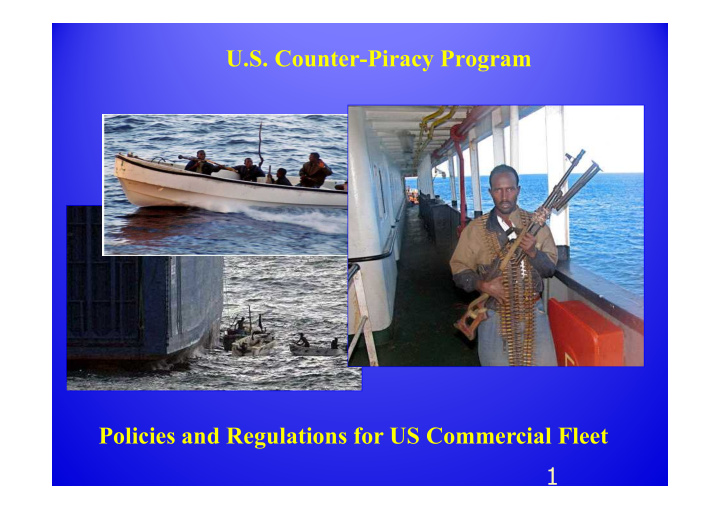



U.S. Counter-Piracy Program Policies and Regulations for US Commercial Fleet 1
US Government Interagency Counter-Piracy Action Plan CP Steering Group - Chaired by DOD/DOS – and members from DHS (USCG), DOT (MARAD), and DOJ U.S. National Counter-Piracy Action Plan CTF – 151: Joint HOA Counter-Piracy Mission (EU- ATALANTA & NATO-OCEAN SHIELD & Independent Countries) U.S. Vessel compliance with Maritime Transportation Security Act of 2012 for Vessel Security Plans USCG Maritime Security Directives (MARSEC Directives) USCG Port Security Advisories (PSAs) DHS/MOTR – Maritime Operational Threat Response
USCG MARSEC Directive 104-6 (series) Under the authority of the Maritime Transportation Security Act (MTSA) regulations, Coast Guard released MARSEC Directive 104-6 (series) to provides direction to U.S. flag vessels operating in high risk waters. Requirements – General Amend approved Vessel Security Plan w/ enhanced measures for piracy Take measures to harden vessel Supplement crew with unarmed security personnel; option to use armed security decision of the owner when needed. MARSEC Directive 104-6 (Rev 6) Published December 30, 2011 Expands West Africa high risk waters 3
The Directive does NOT… Preclude the employment of increased security measures, above and beyond what is required Constrain the captain's ability or authority to make operational decisions Authorize deviation from compliance with U.S. or foreign law or requirements (especially carriage of weapons) 4
Port Security Advisories (PSAs) PSAs provide further guidance to U.S. Flag Commercial Vessel owners and Operators and helps facilitate compliance w/ the Directive. ( 2-09) A non-SSI explanation of the Directive, public releasable (3-09) Guidance on self-defense or defense of others (4-09) International Traffic in Arms Regulations (ITAR) Guidance (5-09) Guidelines for contracted security services (6-09) Procedures for screening of security personnel (8-09) Info regarding carriage / transport of self-defense weapons (9-09) Expected courses of action following attacks by pirates 5
Best Management Practices • Passive Defensive Measures – Comprehensive security plan to include risk assessment – Vigilant lookouts at all times – Speed and maneuver – Limited lighting (navigation lights) – Communicate w/ UKMTO, MARLO, MSC-HOA, ReCAAP – Use of AIS – Participate in group transits • Active Defensive Measures – Protect the bridge, accommodations, and engineering spaces – Secure hatches, limit access to crew and control spaces – Rig barriers (barbed wire & fencing), especially where low freeboard – Non-lethal measures such as LRAD, flares, etc . – Private Maritime Security Contractors as an additional layer of defense, and not in place of BMP
Piracy and Armed Robbery in Asia • Calendar Year 2014 – 183 incidents reported (168 actual and 15 attempted incidents) – 22% increase from 2013 reported and attempted incidents – 13 of them were Category 1 (very significant) and 41 were Category 2 (moderately significant) – 11 of the 13 Category 1 incidents were related to siphoning fuel/oil – Most affected areas for ships underway: Straits of Malacca and Singapore (SOMS), and South China Sea (SCS) • Tactics used by pirates – Involved larger group of men taking control of the ship – Ship crew is tied and locked in the cabins – Cargo, goods, cash and crew belongings removed from the ship – Communications, navigation and emergency equipment destroyed before escaping
Questions? 8
Recommend
More recommend